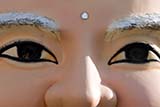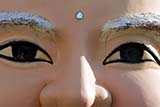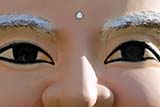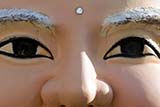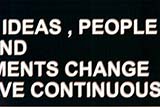Giottos MM 9550 Monopod Review


Sample Images
A selection of photos taken with my Canon EF 300mm f/4L lens and Canon EF 1.4x II extender. The purpose of these images is to show the effects of using a monopod and/or Image Stabilisation when using a fairly long lens and slow shutter speed.
Because of the nature of these test photos, some shots will obviously be very blurred and NO sharpening was performed in post-processing. Hand-holding the equivalent of a 672mm lens on a 35mm camera and shooting at 1/30s is not generally recommended!
Clicking on the thumbnail images will open a larger image in a pop-up window
Lens: Canon EF 300mm f/4L
ISO: 100
Aperture: F16
Shutter speed: 1/30
Focal length: 420mm
Image stabilisation: No
EC +/-: 0
Monopod/Tripod: No
Flash: No
Extender: No
Location: Hat Yai, Thailand
File Size: 86 KB
Lens: Canon EF 300mm f/4L
ISO: 100
Aperture: F18
Shutter speed: 1/30
Focal length: 420mm
Image stabilisation: Yes
EC +/-: 0
Monopod/Tripod: No
Flash: No
Extender: No
Location: Hat Yai, Thailand
File Size: 101 KB
Lens: Canon EF 300mm f/4L
ISO: 100
Aperture: F18
Shutter speed: 1/30
Focal length: 420mm
Image stabilisation: No
EC +/-: 0
Monopod/Tripod: Monopod
Flash: No
Extender: No
Location: Hat Yai, Thailand
File Size: 88 KB
Lens: Canon EF 300mm f/4L
ISO: 100
Aperture: F18
Shutter speed: 1/30
Focal length: 420mm
Image stabilisation: Yes
EC +/-: 0
Monopod/Tripod: Monopod
Flash: No
Extender: No
Location: Hat Yai, Thailand
File Size: 93 KB
Lens: Canon EF 300mm f/4L
ISO: 100
Aperture: F18
Shutter speed: 1/30
Focal length: 420mm
Image stabilisation: No
EC +/-: 0
Monopod/Tripod: No
Flash: No
Extender: No
Location: Hat Yai, Thailand
File Size: 134 KB
Lens: Canon EF 300mm f/4L
ISO: 100
Aperture: F16
Shutter speed: 1/30
Focal length: 420mm
Image stabilisation: Yes
EC +/-: 0
Monopod/Tripod: No
Flash: No
Extender: No
Location: Hat Yai, Thailand
File Size: 146 KB
Lens: Canon EF 300mm f/4L
ISO: 100
Aperture: F16
Shutter speed: 1/30
Focal length: 420mm
Image stabilisation: No
EC +/-: 0
Monopod/Tripod: Monopod
Flash: No
Extender: No
Location: Hat Yai, Thailand
File Size: 161 KB
Lens: Canon EF 300mm f/4L
ISO: 100
Aperture: F16
Shutter speed: 1/30
Focal length: 420mm
Image stabilisation: Yes
EC +/-: 0
Monopod/Tripod: Monopod
Flash: No
Extender: No
Location: Hat Yai, Thailand
File Size: 158 KB
Overview
Choosing a camera body or lens is relatively straightforward. Most of us are locked into a particular manufacturer's system, and depending on our requirements there isn't a great deal of choice.
On the other hand, choosing a tripod, ball head, or monopod can be extremely confusing because of the bewildering number of products on the market. There are lots of manufacturers, different materials, different styles, different sizes, different prices, etc. etc.
With monopods now, there are even gadgets to aid stability. Some have stabilising feet, and Giottos manufactures a model that has three separate legs. These ancilliary legs can be screwed into the base of the monopod to simulate a microphone stand, or two of the legs can be screwed into the collar for low-level shooting - kind of like a machine gun.
I considered this model but it was heavier than other models and I didn't think I would use the three ancilliary legs much.
I also couldn't think why people would want to use a ball head on a monopod. Sure, I understand why on a tripod, but why a monopod? Why would you want to pan a ball head rather than just twist the monopod?
If you need to shoot at an angle you can just incline the monopod but I realised the monopod would be most stable when used vertically.
Eventually I chose the Giottos MM 9550. I like Giottos products because they are well made, well thought out, and reasonably priced. On this monopod there is a built-in tilt head which enables me to shoot high or low while keeping the monopod vertical. It seems a much better (as well as a much lighter and cheaper) solution than a ball head.
The legs lock with a twist action (which I prefer to levers) and the legs have an anti-rotational device so that you can lock and unlock them in any sequence. Everything is very smooth, and the overall feel is that the quality of the manufacturing and materials is quite sufficient.
A circular quick release plate is included which is quite convenient. The locking screw for the quick release plate doesn't work particularly well. Sometimes after locking the plate I can still sense movement, and to clamp it tight needs more effort than should be required.
The flexible rubber foot is a good design. It grips most surfaces well and allows the tripod to be tilted easily without the foor moving. Accessory feet are available for use in snow or sand.
The top section of the monopod has a very comfortable foam rubber grip and a useful wrist strap. A carrying bag is included which may or may not be useful.
The MM 9550 only weighs 860g and it is rated to support 15kg. It folds to 570mm and when fully extended it is the perfect height for me (I am 5'11" so if you are 6'3" it may not be long enough). More details at the Giottos web site.
Choosing a monopod is easier than choosing a tripod, but even with monopods the enormous choice makes it a difficult process. It doesn't help either that we all want to buy the best possible solution for the money we have available.
There are hundreds of reviews on the Internet but what I found is that they didn't help me that much. All they did was confuse me more. Most of the reviews give personal opinions and describe the various models but they miss out the only thing that is of any importance.
It's OK to look at photos of monopods and read about how they work, but all I really want to know is what difference will the monopod make to my photos? The only way to do that is by comparing photos taken with and without the monopod.
That's what I've done here and I have also added photos with and without Image Stabilisation.
Testing Strategy
I used my longest lens combination which has a total focal length of 420mm. Taking into account the 1.6x crop factor of the 40D, this is equivalent to 672mm on a 35mm film camera. Conventional wisdom tells us that we should be using a shutter speed of at least 1/1000s in order to hand-hold this lens combination.
The Image Stabilisation on the 300mm f/4L is quite an old system and should provide one to two stops. I figured that a monopod should also add one to two stops.
Therefore, using Image Stabilisation and a monopod, it should be possible to shoot decent images with this lens at 1/250s, and maybe even down to 1/60s. For my testing I pushed it one stop more to really exaggerate the effects. There is a five stop difference between 1/1000s and 1/30s. How would the images turn out?
I wasn't sure so I attempted to put it to the test. The results should be evident in the photos above. My testing strategy was very simple. For each set of photos I hand-held two shots, and used the monopod for two shots. One shot of each was with Image Stabilisation and the other was with IS switched off.
I used a fixed shutter speed for each photo. I did my best with each shot to hold the camera as still as possible and I didn't brace my body against any solid objects. Before I started, it was obvious that the best shots would be when using the monopod and with Image Stabilisation switched on.
But how noticeable would the results be? And what was the slowest shutter speed I could shoot at with this combination while still getting acceptable results?
Conclusion
My results weren't as conclusive as I thought they might be. What was obvious was that hand-holding this lens combination at 1/30s without using IS produced images that were completely unusable. Even at 1/500s sharpness isn't guaranteed if you are hand-holding without using IS.
The display on the 40D is useless for assessing sharpness. Canon have started using higher resolution displays now (50D and 5D Mark 2) but I have no experience of using these cameras. All I know is that it isn't until I view my images on a computer that I can tell whether they are sharp or not.
What I found in my testing is that there is a lot of luck involved. Some shots hand-holding while using IS were very sharp, and some shots using the monopod without IS were very sharp. Using the monopod and IS together didn't necessarily guarantee sharper results than using IS or the monopod in isolation.
In the photos of the face above, the sharpest image was obtained when hand-holding using IS. I was expecting a sharper photo when I used the monopod and IS but it didn't happen.
With any combination of monopod and IS usage, there was always a degree of movement involved and if that movement occurred the moment I activated the shutter it showed in the image.
Unless you use a solid tripod and ball head, a remote shutter release, and mirror lock-up you will always have some degree of movement. However, in the field it is not always possible to use a tripod.
In that case, there are ways that you can increase your chances of getting a sharp photo but nothing is guaranteed.
As well as always using IS, a monopod, and the fastest possible shutter speed it's probably worth taking multiple images in a burst to increase your chances of getting a sharp one.
I am very pleased with my purchase. The 300mm f/4L (especially when used with the 1.4x extender) is a lens I've struggled with in the past. I've had good results and very poor ones. It's a lens that needs a lot of stability and without that stability results are a matter of luck.
The monopod will definitely increase my chances of getting sharp images and now I regard it as essential when using the 300mm lens.
I can't tell you whether stabilising gadgets on other monopods make a difference because I haven't tried them. A lot do seem a bit gimmicky. In the field, if you can brace yourself against a solid object while using a regular monopod, use IS and the fastest shutter speed, and shoot in quick bursts, you should get good results.
Post-Processing
Images were shot in RAW format and converted with Adobe Camera Raw. Small amounts of image enhancement were applied using Adobe Photoshop CS2 curves. Because of the nature of these tests, NO sharpening was applied
The large JPG images that open if you click on a thumbnail were saved with a 'High' quality setting of '8' on a scale of 0-12.
Other Review Pages You May Be Interested In


